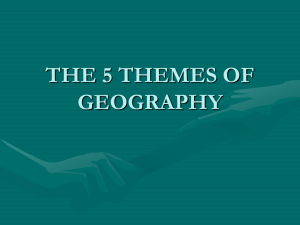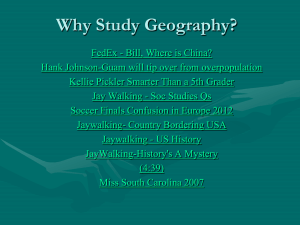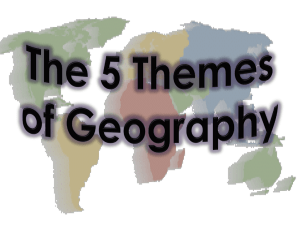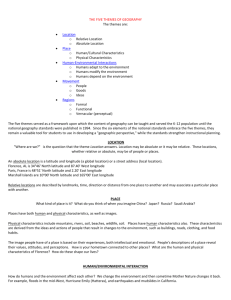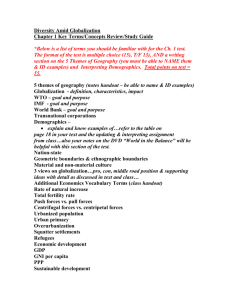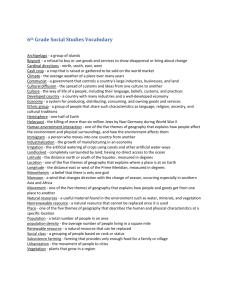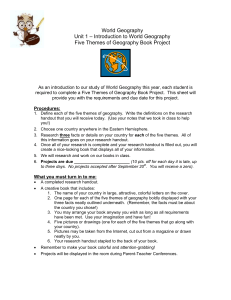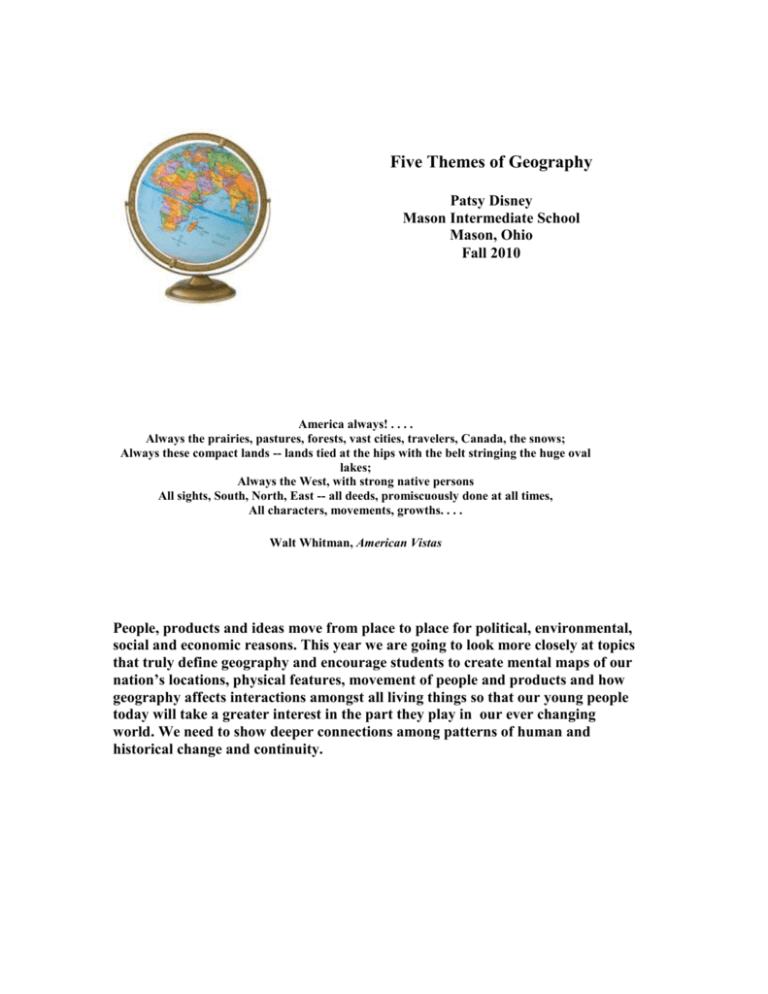
Five Themes of Geography
Patsy Disney
Mason Intermediate School
Mason, Ohio
Fall 2010
America always! . . . .
Always the prairies, pastures, forests, vast cities, travelers, Canada, the snows;
Always these compact lands -- lands tied at the hips with the belt stringing the huge oval
lakes;
Always the West, with strong native persons
All sights, South, North, East -- all deeds, promiscuously done at all times,
All characters, movements, growths. . . .
Walt Whitman, American Vistas
People, products and ideas move from place to place for political, environmental,
social and economic reasons. This year we are going to look more closely at topics
that truly define geography and encourage students to create mental maps of our
nation’s locations, physical features, movement of people and products and how
geography affects interactions amongst all living things so that our young people
today will take a greater interest in the part they play in our ever changing
world. We need to show deeper connections among patterns of human and
historical change and continuity.
Overview/ Materials/LOC Resources/Standards/ Procedures/Evaluation/Rubric/Handouts/Extension
Overview
Back to Navigation Bar
Objectives
Students will:
interpret information from various sources and practice identifying and
organizing the five themes of geography: location, place, region, movement, and
human interaction.
gain experience with using a variety of sources (almanacs, magazines, maps,
trade books, periodicals, newspapers, photographs, and digital resources) to
gather information.
organize collected information in an appropriate format (collage, tables, graphs,
line/bar graphs, charts, or digital images)
use art, writing, and word processing and other multimedia resources to present
to others.
Recommended time frame
Grade level
Curriculum fit
Materials
7-9 days
5
Social Studies and Language Arts
Social studies journal, art supplies, construction paper, Geography poems, magazines,
newspapers
Classroom social studies textbooks, atlases
Blank US maps
Smart Board
Online resources
Graphic organizers
Computers
highlighters
handouts: maps, poems,
Ohio State Learning Standards
Back to Navigation Bar
Social Studies and Language Arts:
1. Analyze different perspectives on a topic obtained from a variety of resources
2. Organize historical information in text or graphic format and analyze the
information in order to draw conclusions.
3. Compare important details about a topic, using different sources of information,
including books and online resources
4. Prepare for publication (e.g., for display or for sharing with others), writing that
follows a format listed on a handout and rubric
5. Use coordinates of latitude and longitude to determine the absolute location of
points in North America.
6. Use maps to identify the location of:
a. The three largest countries of North America;
b. The 50 states of the United States;
c. The Rocky and Appalachian mountain systems;
d. The Mississippi, Rio Grande and St. Lawrence rivers;
e. The Great Lakes.
7. Describe and compare the landforms, climates, population,
culture and economic characteristics of places and regions in North America.
8. Explain how climate is influenced by:
a. Earth-sun relationships;
b. Landforms;
c. Vegetation.
9. Explain how the characteristics of different physical environments affect human
activities in North America.
10. Analyze the positive and negative consequences of human
changes to the physical environment including:
a. Great Lakes navigation;
b. Highway systems;
c. Irrigation;
d. Mining;
e. Introduction of new species.
Day #1: Pretest: Introduction into Geography/Region Unit
(See Handout)
Pretest: Note student strengths, weaknesses, and encourage students who have superb
prior knowledge, when applicable, to prepare a lesson of their own; something that will
expand on our themes; graphs and charts of population growth in the US, occupations
related to our studies, Power Point on the Gulf Oil Spill or other environmental issue in
the news, etc. Discuss the pretest and their interpretation of the word geography, and
student’s prior knowledge. Also note preferences for project presentation at the bottom of
the pretest to incorporate within this and other units.
*Note: Use your own digression on handouts, videos, picture books, and other sources
when teaching this unit. There are too many to list.
Optional Activity: Without looking at a map, list as many places (cities, states, provinces,
geographical features) in North America s you can remember. Create a classification
system for the items on your list. Your classification system may be based on looking at the
places in a different way (in other words, try to go beyond classifying the places as cities,
states, or other obvious categories).
Day #2: Five Themes of Geography Handout:
(See Handout)
Before discussing, instruct students to cut their handout into 5 sections and glue them into
their journals. Leave room for notes.
Power Point presentation (hyperlink below)
https://docs.google.com/leaf?id=0Bx9fG4cyNamBZmFmYzYyMWMtYzMwMy00MmM4
LTgwYTQtZmNhZjBhZjJlZTJk&sort=name&layout=list&num=50
During the Power Point presentation and discussions, have students write the names
/proper nouns of examples shown under the correct thematic heading. Another idea would
be to create alliterative headlines that might be used as a newspaper title about the subject.
See websites noted below.
Handout to coordinate with power point:
(See Handout)
Note how human interaction has changed the landscape and note primary vs. secondary
resources.
Optional Activity: Chart the locations on a U.S. map.
Evaluation: *What is the “big idea” of today’s lesson?
Write what new information you have learned about geography in your journals (or on
lined paper). Collect and review responses. Also the perspective chart could be collected
for a grade.
Day #3: Primary and Secondary Resources: Distinguishing the Two
Have students note page numbers from texts to make it easier to reference 5 themes when
completing additional social studies and writing assignments.
http://www.archives.state.al.us/activity/actvty06.html
Resources attached and secondary resources available in textbooks along with student
knowledge. Students should be taking notes of important concepts being taught in their
journals.
After reviewing definitions and samples of primary and secondary sources available
introduce the students to a variety of websites that show primary sources available for
research online:
Newspaper pages from 1860-1922 http://chroniclingamerica.loc.gov/search/pages/
Newspaper pages from 1690 to today http://chroniclingamerica.loc.gov/search/titles/
Two Voice Poem: Latitude/longitude, state/capitals, absolute/relative
In pairs, have students create one two voice poem to perform. The must work in pairs,
research the topic (this is where page numbers come in handy) and incorporate facts into
their writing piece.(Latitude/longitude, state/capitals, absolute/relative, and
primary/secondary). Evaluation: Rubric is optional: definition and accurate examples of
topic were incorporated in student’s poem, effort, etc.
Day #4: Review of Location: Absolute and Relative Location/ Primary/Secondary
resources.
National Geographic Website: I used this website as a reference guide to compliment all
the daily lessons. I rewrote suggested activities into my lesson plan because as a reference
tool I would misplace the hard copy handout. I found this website invaluable, thus giving it
credit numerous times in this lesson plan.
http://www.nationalgeographic.com/resources/ngo/education/themes.html
Optional journal entries I found valuable were:
List 4 ways your hometown is connected to a nearby town or city you have located on a
map.
Use latitude and longitude lines, locate the national park nearest your town, three major
cities in your state, three major cities you’d like to visit in the United States, and four
major cities from each of the 4 hemispheres.
Compare and contrast the equator and the prime meridian. Write at least 5 entries.
Name the four major rivers in the U.S. and from where you live, describe their locations
using relative locations. Using absolute locations locate the source of these rivers.
Discuss how we can distinguish latitude/longitude. Read poems, play coordinate games,
and have students illustrate a way to differentiate the two. Provide handouts on
latitude/longitude practice. On the page of Location notes, instruct students to draw their
house and write their address inside the house. Label it absolute direction. Draw a sketch
of your school. Write a sentence with a cardinal direction or intermediate direction that
states the relative location of the school from your house.
National Geographic Map Maker
At this site you can choose your state or any state and request the site show areas of
climate, transportation, agriculture, biology, boundaries, highways, capital cities, major
cities, etc. and print your research results.
http://www.nationalatlas.gov/natlas/Natlasstart.asp
Day #5-6: Place vs. Region
National Geographic Website
http://www.nationalgeographic.com/resources/ngo/education/themes.html
Place: physical characteristics include such elements as animal life.
Human characteristics of the landscape can be noted in architecture, patterns of
livelihood, land use and ownership, town planning, communication and transportation
networks, languages, religious, political to help shape the character of a place.
Optional Journal activities I found valuable were:
Explain how one’s physical environment has affected the way your family lives in Mason,
OH. Give specific examples to support your ideas.
Walk around the school grounds. Make a list of all the physical and human characteristics
that you observe. Did you observe the same characteristics? Different characteristics?
Have you ever made these observations before?
What are the geographic features of your community?
Region: Using a variety of resources, show students examples of maps and discuss the
why’s and how different resources divide our nation differently. Depending on the source,
the U. S. can be divided into as many as 13 regions.
Using the blank map of the U.S. provided during the Power Point presentation, now color
the 5 regions our district concentrates on.
Activities:
Give each student a folded piece of paper on which you have written the name of a place
that is known and easily described by the students. Ask each student to write a description
of the place without naming it, then exchange descriptions with another student. How
many can identify the place from its description alone? What makes one description easier
or harder to guess than another?
Learn the words and sing “Home on the Range.” Discuss how the song describes a
particular place. What kind of place is it? What are its physical and human
characteristics? What other songs do the students know that describe particular places?
Provide newspaper articles of any two cities currently in the news to locate on a map.
Assign teams of students to research and to present their findings on ways in which the
two cities are connected. They might be linked, for example, by human-migration routes,
weather patterns, economic concerns, communication systems, or transportation
networks.
Classroom Regions Assignment: Identify five regions in your classroom. Notice what each
areas of the classroom are used for. What do things in that area have in common? Give
each region a name and write a paragraph explaining what makes that area of the
classroom a specific region. Create a map that shows each region reflecting on how the
classroom is organized. Evaluate student’s work on effective division into 5 regions,
explanations with specific information for creating the regions, clear descriptions of each
region, and a vividly illustrated map of 5 classroom regions.
Writing Assignment: My Aunt Came Back From Crazy Gibberish by Naomi Baltuck,
Have students choose any person or thing to travel to 5 regions in the U.S. They must write
a minimum of 5 couplet verses. They must incorporate in their couplets an example of an
item/s listed on the five themes of geography handout pertaining to the region they visited.
Additional assignment: ABC’s of a Region Skim your textbooks researching a particular
region (textbook pages come in handy again) and in complete sentences, write information
pertaining to each letter of the alphabet that you gather. Underline the words that begin
with that particular letter. Example:
A Alabama and Arkansas are 2 states located in the Southeast.
B The capital of Louisiana is Baton Rouge.
Have students share the importance of other fictional regions in stories and books they are
reading in English class. Discuss how regions play an important role in storytelling and in
literary analysis. Have students make up a story, creating a fictional region defined by the
characteristics of the landscape and the people.
Optional Journal activities I found valuable were: Skim the texts: Have students list items
that they would need to adapt to the 5 different environment when visiting each specific
region. (Items might include food, clothing, insect repellent, ice ax, etc.) How many of the
items do they have to buy? What kinds of items do people who live in the northeast region
have in common with people who live in the southeast region? What items are unique to
one region? What items are manufactured in their region? What items are imported?
What items are absolutely essential? Name some overlapping characteristics among the
regions.
Have students trace the history of regions in the United States. What regions existed in
1700, 1750, 1800, 1850, 1900, and in 1950? Divide students into “century groups” (for
example, 1700, 1800, etc.). Which regions in each century group still exist today? Why or
why not? Have each group research why regional boundaries did or did not change and
then present its findings to the other groups.
Day #7: Movement
National Geographic Website
http://www.nationalgeographic.com/resources/ngo/education/themes.html
Make a comparison chart of human-made transportation systems (cars, planes,
communication systems, etc.) and natural movement systems (weather, erosion, tides, etc.)
List the different “passengers” that are transported by the two different kinds of
transportation systems (tangible goods like foodstuffs, intangibles like sound and light,
ideas). People interact with other people, places, and things almost every day of their lives
through travel, communication, and rely upon products, information, and ideas that come
from beyond their immediate environment. Students should be able to recognize where
resources are located, who needs them, and how they are transported over the earth’s
surface. Movement helps students understand how they themselves are connected with,
and dependent upon, other regions, cultures, and people in the world.
Teach how waterways (oceans, rivers, canals, etc.) played an important role in the overall
history and population growth of our great nation.
Optional Journal Activities:
Look under “Churches” in the yellow pages and make a list of the different religious
groups represented there. Research the origins of the selected groups. Plot the origins of
each group on a map of the world. What are some of the reasons that these religious
groups moved to the United States? What are the historical, political, and cultural factors
involved?
Make a list of 12 items in the classroom that have been manufactured in the United States
(clothing pencils, books, etc.) How many items can you name that have been manufactured
in another country? Discuss ways ideas travel from place to place (music, literature, story
telling). How do people react – personally, professionally, politically, technologically -when
they are able to freely communicate with one another? In what ways are people prevented
from experiencing the movement of ideas? (censorship, geographic barriers, language
barriers). What happens when people are not able to communicate?
Explore and compare different types of movement. For example, compare the movement
of blood and nutrients through the body with the movement of people and resources
across bodies of land and water. How does a person feel when food isn’t moving properly
through the digestive system? What happens to the movement of traffic in a city when
traffic lights are broken? (Examples might include traffic jams, short tempers, etc.) Note
that we use the word “congested” to refer to people with colds as well as locations with
heavy traffic. How do ideas move? What would happen if goods, ideas, or people stopped
moving?
America on the Move: Smithsonian
http://americanhistory.si.edu/onthemove/exhibition/exhibition_1_2.html
Students could illustrate, then paste finished paragraphs in their journals in the
appropriate section.
Extension: Invite a local weather forecaster to join your class to discuss climate conditions
in your area over the last century. Are data available to indicate climatic changes? If so,
what are the possible causes? Urbanization? Volcanic activity? Transportation systems? Is
it warmer in the city or in the country during the summer months? Why? Study the ways
in which farmlands can be changed into city landscapes. Have a student sign up sheet to
report the daily weather forecast.
Day #8: Human Interaction: Positive and Negative
Return to the Power Point listed above and discuss: National Geographic Website
http://www.nationalgeographic.com/resources/ngo/education/themes.html
Sometimes a human act, such as damming a river to prevent flooding or to provide
irrigation, requires consideration of the potential consequences. (Hoover Dam on the
Colorado River- changed the natural landscape, but created a reservoir that helps provide
water and electric power for the arid Southwest.) Studying the consequences of
human/environment interaction helps people plan and manage the environment
responsibly.
Create 2 lists/comparison chart: List 1: ways people affect their environment every day
(driving cars, using water, disposing of garbage, smoking cigarettes). List 2: ways people
affect their environment through seasonal activities (watering lawn, burning leaves,
fishing, hunting). Compare two lists and discuss which activities are more harmful/helpful
to their environment. Suggest ways people can change their behavior and improve their
environment.
Struggling to Survive: Read aloud paragraphs or chapters from stories about people who
struggle to survive in an unexplored environment (Sign of the Beaver, Hatchet, Island of
the Blue Dolphins) Discuss ways in which the characters learn to adapt to their
environment. How and where do they find food? Clothing? Shelter? How does their
environment change as they begin to create a home for themselves? Compare ways in
which they adapt successfully or unsuccessfully.
Optional Journal Activity: List ways in which the people of your town or city have
changed their environment over the years. Collect representative photo, both old and new,
of your town or city, and photocopy them. Compare all the photos and observe how places
and people have changed over the years. Are there more buildings? Different kinds of
buildings? What are the differences in kinds of transportation? Are there as many trees in
the older photographs as there are in the newer ones? List ways in which the people of
your city have changed their environment over the years.
Dynamic maps are innovative illustrations of geographic phenomena.
This site covers such topics as invasive species, and wildlife mortality
http://www.nationalatlas.gov/dynamic.html#one
Have students refer to textbooks and atlases available to share examples and note those
examples of invasive species in their journals with illustrations and captions. Another
great source is Time For Kids which keeps us abreast of current events.
Extensions/Careers: The Seven Necessary Occupations
http://www.teachervision.fen.com/tv/printables/0876281870_191.pdf
Career goals present, 4 year and future
http://www.atozteacherstuff.com/pages/279.shtml
Agricultural Career Guide
http://www.khake.com/page39.html
On-going Evaluation: *What is the “big idea” of today’s lesson?
How are improvements in transportation a positive change? Negative change to our
environment? Support your answer with specific information and examples you remember
from your notes, textbook, and class discussion. *Give your opinions, observations, and
wonderings. Start your sentences with:
“I think ….”
“I wonder …”
“I didn’t agree …”
“Wow, I never knew …”
Encourage students to provide a variety of answers, offer observations, as well as give
opinions and facts.
Final project: See Handout
Evaluation
Back to Navigation Bar
Daily Journal of important concepts taught prompt: Whether you use state issued essential
questions or create your own, keep them open-ended. The prompts should encourage
students to reflect on the “big ideas” of the lesson and be very broad in nature. They
should also be a study guide for the upcoming unit PI or test.
Examples:
*What is the “big idea” of today’s lesson?
*Support your big idea with specific information and examples from your notes, textbook,
and class discussion. *Give your opinions, observations, and wonderings. Start your
sentences with:
“I think ….”
“I wonder …”
“I didn’t agree …”
“Wow, I never knew …”
Encourage students to provide a variety of answers, offer observations, as well as give
opinions and facts. Rubric/grading is optional.
Content Elaborations
As students interpret information from various sources, they can practice identifying and
organizing main ideas and supporting details. Students can organize collected information
in an appropriate format (outlines, tables, graphs, line/bar graphs, charts, or digital
images) and use word processing or presentation software and multimedia resources to
present to others.
Extension
Back to Navigation Bar
1. Geography All Around Us:
Select current events in the news that fall under one or more of the five themes of
geography. Your stories can be from Time For Kids magazines, local newspapers,
online news: Valuable resources I found include:
http://www.educationworld.com/a_lesson/archives/newsforyou.shtml
http://news.nationalgeographic.com/news/
http://www.cnn.com/
http://www.mywonderfulworld.org/pdf/educators_top10.pdf
Present your article to the class by giving an oral summary. Ask your audience
which theme (s) your story falls under. You will have 2-4 minutes to present.
Display your article in the hall with the geography projects. This could be an
ongoing activity where each student is assigned a day to present for the duration of
the school year. You might want to make it into a weekly newscast video.
2. Write persuasive letters to interested parties.
Use multiple sources and appropriate communication tools to locate, investigate,
organize and communicate information on a public issue dealing with an
environmental issue or natural disaster in a given region.
3. Greatest Hits CD: Create a musical CD with 10 track titles that reflect what
students learned from the unit. Refer to their textbook, journal, and class notes
when thinking about their song titles. They must also design and create their own
CD case. Be prepared to explain your song title choices to the class. Extra credit:
Write the lyrics to one or more of their songs or perform your song on the project
due date.
4. Acting Out History
http://www.actingouthistory.com/about_the_method_articles/HowToAOH.pdf
Primary Resources from the Library of Congress
Back to Navigation Bar
One of the leather-bound notebooks
had to be taken apart before the
pages could be scanned safely.
Typical of Whitman's notebooks,
this one had some pages sliced out
and others glued in.
The wireless device, which allows
users to download electronic books
directly, can hold up to 200 books
and even displays graphics.
Adapted from the Library of
Congress Gazette, March 24, 1995
With exception of the first
photograph by LC's Photo
duplication Service, these
photographs were taken by
Merrilee Love Oliver.
Let’s stay in touch.
BeRelevant [at] EarnedRelevance
[dot] com
Capital Traction Company
motorman and conductor
Date Made: about 1900
Location: District of Columbia
In Washington, two men operated a
streetcar. In 1900, the nation's
streetcar men worked an average of
twelve and a half hours a day.
Motorman and conductor of a
Capital Traction Company
streetcar, Washington, D.C.
Library of Congress, Prints and
Photographs Division
http://memory.loc.gov/ammem/col
lections/whitman/wwntbks.html
http://memory.loc.gov/ammem/col
lections/whitman/gazphoto.html
http://t1.gstatic.com/images?q=tb
n:ANd9GcTGK_CTxg1i5UrOuyl
kxZC8mKNkCTamtUIgh6i0boyvyWs21I&t=1&usg=__qi
Q4tqmBEw9yshgX8D9Ji4vjSw4=
http://americanhistory.si.edu/onth
emove/exhibition/exhibition_4_6.h
tml
http://acuteconsulting.files.wordpr
ess.com/2010/08/washington-dcmetro-train-half.jpg
The Washington DC Metro has a
fleet of 958 cars.
Size:454 × 500Type:204KB JPG
Title: The May Flower, 1620
Mayflower Ship Launching
Site today
Title: Summits of Rocky Mountains
near lat. 49 N
̊ ., July 1861
Summary: Photograph shows peaks
of the Rocky Mountains along the
boundary line between United States
and Canada at latitude 49 ̊North.
Salt Lake City, Utah
Rocky Mountains in the background
Title: Folding Paper Box Company,
South Bend, Ind. About 6 young
boys and girls here, but could not get
photographs. Location: South Bend,
Indiana.
Creator(s): Halsall, William
Formby, 1841-1919, artist
I liked the Mayflower
Pub which
commemorates the place
where the Mayflower
ship launched for
America. We de-boated
in Greenwich about lunch
time. We found a local
pub and had fish & chips
and a cold lager. (They
actually serve it cold
now.)
Call Number: Unprocessed in PR
13 CN 1999:001.01 [item] [P&P]
Repository: Library of Congress
Prints and Photographs Division
Washington, D.C. 20540 USA
Size:423 × 277Type:34KB
JPG
Creator(s): Hine, Lewis Wickes,
1874-1940, photographer
Created/Published: 1908 October.
Part of: Photographs from the
records of the National Child
Labor Committee (U.S.)
http://www.loc.gov/pictures/resou
rce/det.4a26405/
http://startcookin.com/category/tr
avel/
http://www.loc.gov/pictures/item/2
003668218/
http://www.westsrbdio.org/latest_
news/images_visitations/salt_lake_
city1985.jpg
http://www.loc.gov/pictures/item/n
cl2004000248/PP/
South Bend,heart of the nation's
industrial belt. With a location on
the beautiful St. Joseph River, South
Bend is home to the University of
Notre Dame, which is nationally
recognized for its academic
excellence and for "The Fighting
Irish," its winning football team.
Dole Pineapple Plant
Honolulu, Hawaii
Dole Pineapple Plant today
http://www.answers.com/topic/sou
th-bend-indiana
Size:250 × 188Type:29KB JPG
Hawaii Plantation Village
Dole Pineapple Factory
Dole Plantation on Oahu.
Of course it’s a tourist
trap filled with novelties,
magnets, and collectible
thimbles, but it’s one of
the best tourist trap that
we’ve ever been to.
Title: Aerial view of
Waikiki Beach and
Honolulu, Hawaii
Creator(s): Highsmith, Carol M.,
1946-, photographer
Created/Published: 2005
December 10. Repository: Library
of Congress Prints and
Photographs Division
Washington, D.C.
Title: Storm in the mountains,
Hawaii
Creator(s): Highsmith, Carol M.,
1946-, photographer
Date Created/Published: [2005
December]
http://4.bp.blogspot.com/_ttqbGV
wWYY/SksucL9Sv0I/AAAAAAAA
Juo/wGZnKrG4Sew/s320/plantati
on.jpg
http://www.jaunted.com/files/1494
3/IMG_0469.jpg
http://www.loc.gov/pictures/item/2
009634056/
http://www.loc.gov/pictures/item/2
010630463/
Title: Scene painter amid
earthquake rubble painting picture
of ruins of large building after San
Francisco earthquake-fire. 1906
Created/Published: 1906. 1
photographic print. Reproduction
Number: LC-USZ62-64748 (b&w
film copy neg.)
Title: Calif. - San Francisco Earthquake & fire, 1906 "Ruins on
Kearney St. near Post
Created/Published: c1906.
Medium: 1 photographic print.
Reproduction Number: LCUSZ62-47147 (b&w film copy
neg.)
San Francisco Bay Area
Location:
We are a San Francisco-based
real estate valuation firm
Title: New York City: Brooklyn
Bridge from Brooklyn
Created/Published: c1901.
Medium: 1 photographic print.
Reproduction Number: LCUSZ62-79048 (b&w film copy
neg.)
When it was completed in 1883, the
Brooklyn Bridge was a marvel of
civil engineering—the longest
suspension bridge in the world. Over
150,000 people walked across the
bridge opening day.
Pedestrian access at City Hall
Park
Financial District
New York City , New York
10007
http://www.loc.gov/pictures/item/2
003679673/
http://www.loc.gov/pictures/item/2
006688496/
http://www.google.com/url?q=http
://www.advancedappraisal.com/&ei=jQ2gTP2zH4
H6lwe896HqAg&sa=X&oi=unaut
horizedredirect&ct=targetlink&us
t=1285559445532918&usg=AFQj
CNEEnH6htzNAjVdzF8rd-glh404UQ
http://www.loc.gov/pictures/resou
rce/cph.3b26128/
http://www.concierge.com/travelg
uide/newyorkcity/seeanddo/18018
Thousands of European
immigrants and American
pioneers began their travels to the
western reaches of the United
States on the "Albany to Buffalo"
route of the fabled Erie Canal.
Size:685 × 432Type:187K
B JPG
Title: Tanker churning out of Lock
Eleven, Erie Canal, New York
Creator(s): Collier, John, 19131992, photographer
Created/Published: 1941 Oct.
Erie Canal Lock #2, Waterford
Visitor Center, Waterford, NY
Buffalo, NY has a number of
vacant grain elevators frequently
labeled 'white elephants' with no
reuse potential. But other cities
have found ways to preserve their
industrial heritage.
abandoned factories in South
Chicago and Gary,
Size:618 × 379Type:265K
B JPG
Rather than demolish a
remnant of its riverfront
industrial district, the City is
thinking beyond the condo
box. The plant site, in true
Portland style, is planned to be
converted into a mixed-use
complex of restaurants,
retailers, entertainment and
open space with a ‘green’
focus.
Images on this page
Copyright 1995,1997
David Rochberg. All
Rights Reserved
http://www.conigliofamily.
com/images/AlongTheErie
CanalAtBuffalo.jpg
http://www.loc.gov/picture
s/item/fsa2000052548/PP/
http://t1.gstatic.com/image
s?q=tbn:ANd9GcRuhhrOr
VOdGzM_Ty1Aq0CA_49
T33Z1ukcVmDL2gBEnRdZKXU&t=1
&usg=__CDjHRanNN9mz
5TT5BTvwsI3bTkw=
http://archives.buffalorisin
g.com/img/img_entries/w6
00/19057.jpg
http://david.rochberg.com/s
teel/legacy/buffalo/
Absolute Location Example
Hypertext Transfer
Protocol
http://www.hightunnels.org
/images/latitude%20and%2
0Longitude%20Map.gif
Region ____________________________________________________________
Student Name ____________________________________________________
Famous
People
Places
Landforms
Historical
Event
Landmarks
Human Changes
Rubric
Back to Navigation Bar
Replace this text with an assessment rubric for your learning experience. There are some excellent web sites such as
http://rubistar.4teachers.org/index.php that simplify rubric development.
Five Themes of Geography
Name ____________________________ Date ____________
Due Date ____________
Create a collage that reflects the meaning of the five themes of geography: location,
place, region, movement, and human interaction. (Note: If you prefer to make
something other than a collage, get approval from the teacher.)
Definitions and examples of these five themes are located in the following textbooks
and notes from your social studies spiral notebook:
US Early Years (New text)
p. GH 2-3
SS Alive (Green text)
p. 11
US and Its Neighbors (Old red text)
CH. 1
More information can be found on the internet.
You may use magazine clippings and your own illustrations for the collage. Use a
variety of images. The words location, place, region, movement, and human
interaction should appear prominently on your collage and sectioned by topic. Make
sure your visuals are neat and detailed.
Review the rubric below to make sure you’ve effectively completed the work on which
you will be assessed.
SCORE
1
2
3
4
1
2
3
4
1
2
3
4
1
2
3
4
CRITERION
Student created a collage with the
images that reflect the meaning of the 5
themes of geography.
Student utilized unique and original
perspectives when choosing images.
Student created a neat, organized
collage; white space was minimal.
Student provided clear explanations of
how the images they chose represent
their own feelings and beliefs about the
words.
Handouts
Back to Navigation Bar
Five Themes of Geography: Vocabulary/Ways to Look at a Region
Location
Absolute: a location can be absolute (specific) as defined with latitude and longitude lines; coordinates
Where were you born?
Where do you live? Write down your street address
Where is the most beautiful place you’ve ever been to? Where is this place located?
Relative: in the same general location as another location
Example: next to the school, next door, down the road from…., North of….. SW of …
Place
Antarctica South Pole
School includes wall, windows, gym, cafeteria, classrooms, people, clothing, books, maps, hallways, and
everything else in the school, including the languages spoken there
What human-environment relationships are occurring?
Physical features
human features
rivers
cities
language
tradition
landforms
waterways people
climate
languages
communication
transportation
ecosystems natural resources
environmental pollution
Region
Larger than a place or location
Defined by certain unifying, similar characteristics such as climate or industry
Geographers also study characteristics on how regions around the world may change over time
Physical/ natural
Deserts
mountains
grasslands rain forests climate
Human
Religion
language
industry vegetation
cultural Commercial residential
business
Movement
The way people, products, information and ideas move from one place to another
Local: how did you get to school today?
Global: how did humans get to North America
Deals with how and why people travel from one place to another.
Why does movement occur? Careers, to be close to family, to escape war, religious persecution
How do people, goods, and ideas move to and from this place?
Geographers study how products and resources are transported from one region or place to another;
manufactured products, crops, oil
How people move for a better life/better land/
Human Interaction: Positive and Negative
How do people depend on the environment?
How does this place affect the people living here? Population? Settlement patterns?
How do people adapt to the environment?
How do the people who live here affect this place? How do people modify the environment?
Lasting effects these interactions may have on a place. Damming a river, polluting the air, building highways
or railroads, watering lawns and gardens, planting trees? Creating landfills?
Five Themes of Geography Pretest
Name _____________________________________________________ Date _____________________
Define geography: _____________________________________________________________________
_____________________________________________________________________________________
List the five themes of geography
1.
____________________________________
2.
____________________________________
3.
____________________________________
4.
____________________________________
5.
_____________________________________
Example
_______________________________
_______________________________
_______________________________
_______________________________
_______________________________
Define absolute location: _______________________________________________________________
Example of absolute location: ___________________________________________________________
Define relative location: ________________________________________________________________
Example of relative location ____________________________________________________________
Define positive ___________________________________
negative __________________________________
Define climate ________________________________________________________________________
Give me an example of any US landform __________________________________________________
Give me an example of a language _______________________________________________________
Give me an example of transportation ____________________________________________________
Give me an example of a natural resource _________________________________________________
Give me an example of environmental pollution ____________________________________________
What is a region? ______________________________________________________________________
Give me an example of a region __________________________________________________________
Define human interaction _______________________________________________________________
How do people depend on the environment? Give me 2 examples.
______________________________________________________________________________
______________________________________________________________________________
How do people adapt to the environment? Give me 2 examples.
______________________________________________________________________________________________
How do people modify the environment? Give me 2 examples.
______________________________________________________________________________________________
For a project would you prefer to share your knowledge by: Check 3 choices;
1 being your first choice
___ Student created skit
___ Poetry book
___ Puppet Show
2 second choice
___ Power point presentation
___ Make a magazine
___ Musical CD
3 third choice
____ Poster or collage
____ Create a newscast
____ Art Portfolio
NAME ______________________________________________ DATE ___________________________
OBJECTS IN
SLIDE
ABSOLUTE,
RELATIVE
LOCATION
FROM
MASON, OH
PLACE
MOVEMENT/
CAREERS
HUMAN INTERACTION
+
-

